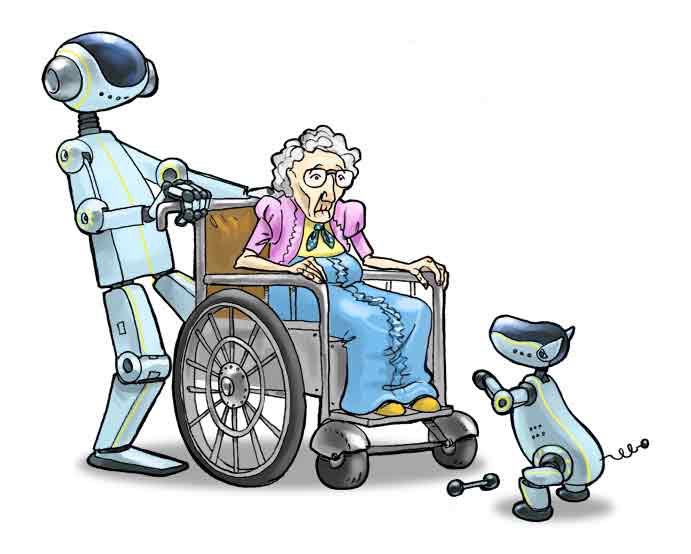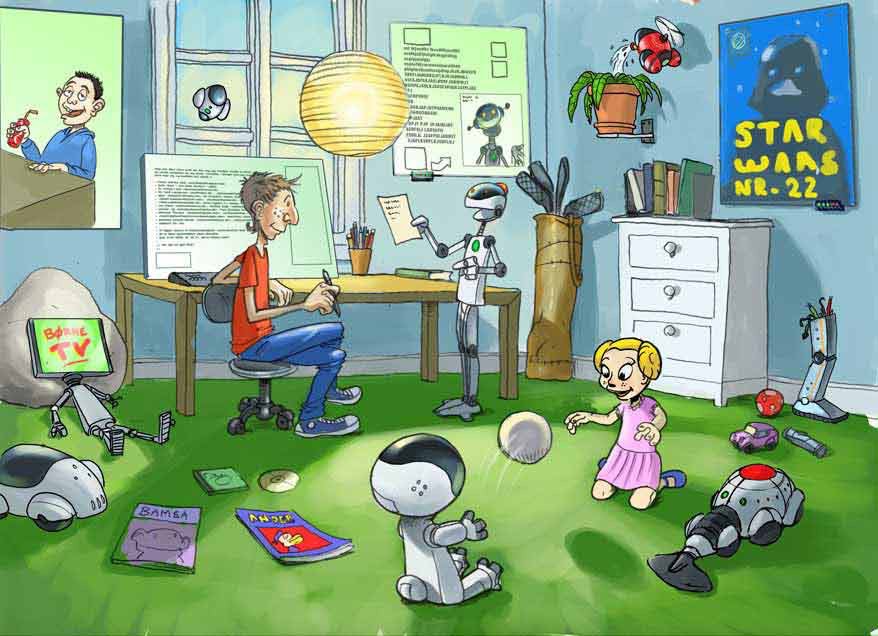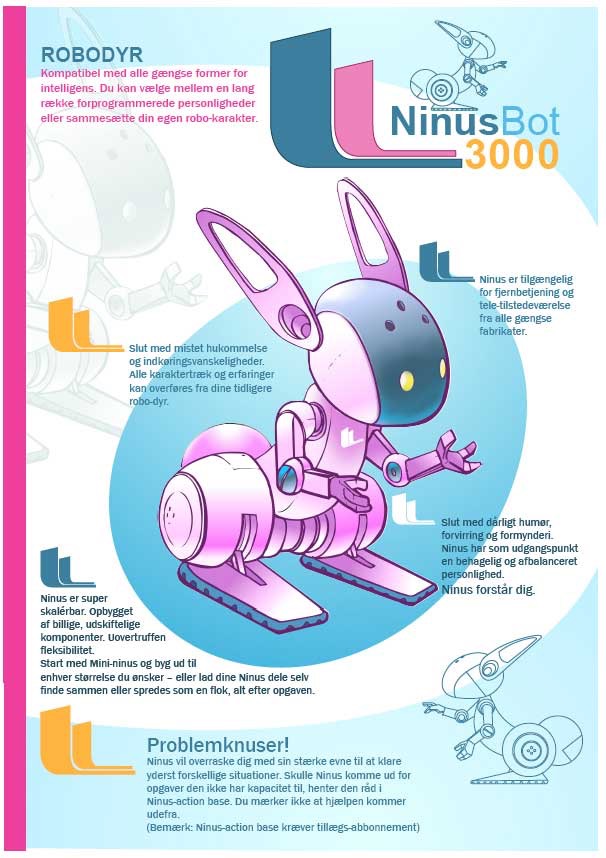
The other Sunday, the Jensen family was watching an old Disney movie, The Beauty and the Beast. One of the central scenes in the old film is when the beauty arrives to the enchanted castle where teacups, kettles, watches and chandeliers are singing and dancing.
The children of the Jensen family were puzzled by the amazement of the young girl, the beauty. In the old movie, it was magic to have paintings and lamps moving about. To the kids today, that is what we expect objects to do.
The kids brought the issue up for discussion at dinner that night. 8-year old Anna had just gotten a new doll. It had immediately become her new best friend. It had a lot more skills and understood her far better than her old doll. But she felt a little bad about not having recharged her old doll since she had received the new one. She knew that the moment she pressed the “on” button, it would know that it was no longer the most important doll in Anne's life.
“Oh, don't worry about it”, her mother said. “Even if it cries, it's not really sad. It's just doing what it's designed to do.”
Anne's older brother, Anders, told that in school he had heard about the three different states of existance: You could be dead - like a rock. You could be living, like a human being or a cat. Or you could be a animated machine - like a fridge.
The funny thing about the Disney film was that it was obviously from a time when people considered machines and objects to be dead like doornails - which - as both mom and dad pointed out, was not that long ago.
The perception of machines gradually started changing in the early years of the millennium, when people began sensing that there was “something” inside their various gadgets. With each new and improved model - whether it was a mobile phone, a car or a washing machine - technologies were refined and the machines became increasingly better at making decisions and solving problems. It was like they developed and enhanced their personality on the basis of their experiences with the user and the surroundings in which they operated.
When mom and dad were kids, the car would not automatically hit the brakes if something got in the way, and the washing machine would continue its set program even if everything inside it was turning pink thanks to a red sock accidentally thrown in with the white linen.
Yes, and do you remember when we first met a robot officer. Bla bla bla... Anders and Anne looked at each other. Once their parents got started about the old days there was no stopping them. That was the problem with adults, you couldn't simply change the subject or switch them off.
The Same Set Of Senses - Embedded In Everything
Contrary to the predictions, computer technology advancements did not slow down. Processors grew increasingly powerful but the extra power was not employed for enhancing video quality or to further speed up search functions. Instead, developments now focus on making computers increasingly human - a task which puts heavy demands on power and advanced programming.
In a manner of speaking, computer power has become a set of senses that can be embedded in all kinds of objects - much like electricity became incorporated in all kinds of objects, toothbrushes, stoves, etc., in the 20th century.
The mobile phone is the epitome of the development. Basically, a mobile phone was nothing but a computer chip with a microphone, a loudspeaker, a camera, the ability to transmit signals, and enough power and memory to work as a calendar, notebook, game machine, etc.
Later, the ability to register exact location was added - plus a number of sensors measuring temperature, humidity, chemicals, etc. As mobile technology grew cheaper and became more compact, it rapidly outgrew the physical confines of traditional telephony and handheld devices. The same set of qualities could be built into any household object - as is evident now. In a car, the device will keep track of the weather, contact emergency centers if relevant, and receive notice of service check-ups, etc. In a thermos, it registers how much coffee is left, it shows the temperature and orders refills.
Today, the applications of the original mobile phone are available in milk cartons, bicycles, clothing, shoes, walls - everywhere. In a sense, our surroundings have become sensitive. At the same time, they have become far better at analyzing what they see and linking it to the observations they receive from the other types of objects with which they are interlinked.
Development in this area is accelerating at a still higher pace - which is why everything around us seems increasingly alive and conscious.
The Revolution Started In The Nursery

No wonder that children accept machines as living beings without much ado; they were raised with the toys that led the development. Since the beginning of time, children have loved to play that their dolls were alive. Even if some people will still claim that the quality of the play experience is the same whether or not the doll is realistic or computerized, the toy industry has always pushed hard to make their dolls, robots or cars more appealing by adding the most advanced technologies.
Toys are an ideal outlet for rapidly changing technology. We don't usually change the fridge or the car very often, but the children's rooms overflow with an ever-changing assortment of cheap, state-of-the-art technologies. Toys are replaced at a tremendous pace and nobody would ever complain if they do not work quite as expected - children have no reservations or technological phobia, but plunge unconditionally into a relationship with the machine.
The “Tamagotchi” was a milestone in that respect - a brief, but worldwide craze around the turn of the millennium. The idea was extremely simple: the Tamagotchi was a minimal video game featuring a figure demanding some push-the-right-button attention from its owner at regular intervals - or else it would die.
Today, it seems ridiculous and hard to understand, but at the time, lots of people were in fact offended and concerned that children would form an affectionate relationship with a thing.
Well, things have changed rapidly since then. Aibo, Sony's robot dog, was another important step forward. To begin with, the small robot was extremely costly and its qualities quite limited. Nonetheless, Aibo became the ancestor of the entire robo-animal industry.
According to Eurostat, each household in the EU region has an average of 12.4 robo-pets and even if each child has at least two or three pets, they are by no means all toys. Imagine what life would be like without robo-animals to do all the household chores of cleaning, vacuuming, monitoring and locating lost things and objects.
It is amazing that only a few years back, a worker or repairman, etc., would painstakingly get into his car to personally go fix even the simplest tasks at people's homes. Today, even advanced robo-animals will earn back the investment within just a few years, simply because of the cost-savings from having workmen, housing advisors, doctors and all other kinds of personal service personnel use the robot as their tele-presence. A robo-consultation is far cheaper - especially if you use the services offered via India or Bangladesh - than a traditional house call and usually does the job equally well. Using the robot's camera, microphone and arms, the specialist can generally form a very good overview of the situation and usually have the problem fixed long-distance.
The popularity of the robo-animals went hand in hand with the general aging of the population. To thousands of elderly, the robo-animals offer the help and safety that make it possible for them to handle their own affairs and stay in their own homes.
But obviously, it has given rise to some controversy. Ever since the Japanese started using robo-animals on a large scale in their public care services, critics have discussed whether the technology serves to improve conditions or merely is a means to saving money.
Elias Vindbjerg from the Northern European People's Party never doubted the rationale: “It's a disgrace! Our worst fears have come true. Government uses automation as an excuse for rationalizations leaving thousands of weak and elderly with nothing but a robot for company and care - while lots of young people in our less fortunate partner states og unemployed.”

A Reflection Of Ourselves
Once, machines were stupid. They did exactly what they were told to do - and nothing else. It must have been quite an ordeal for the human user to give instructions to the machine having to constantly take into consideration all kinds of unexpected events.
The neural networks, learning software and emerging artificial intelligence changed our approach to machines. “Programming” a machine today is much like training a dog - or raising your children. When you first unwrap the machine, it is a helpless infant, but as it gets access to and interlink with the owner's other machines, it will start solving its tasks as best it can. In a process of trial and error, constructive criticism, input and feedback from the owner, the machine will gradually learn to understand its owner's needs, wants and preferences - and become mentally awake and flexible to the point where it no longer needs instructions, but can find solutions to new problems and unexpected situations on its own. Like children, machines never stop to learn. They observe, analyze, adjust and refine their problem solving strategies.
And like with children or pets, the individual and the machine will build a close relationship - having gotten to truly know each other.
Understanding and accepting machines as partners and even friends, is a significant change of mindset from a philosophical point of view.
Anthropologist Inga Gühlent says that it used to arouse suspicions and social problems if a human being would admit being close to his or her robo-animals. Today, the situation is almost reversed:
“Everybody knows that training a robo-animal is no easy matter, and obviously the process will lead to some degree of bonding. It is indeed a huge project, but a well-functioning robo-animal is crucial to making our everyday lives work”, says Gühlent.
Being Emotional Is A Strength
As early as in 2014, a report from the Department of Science concluded that “The world is far more complex and changeable today - and there are no indications that things will ever return to a more simplistic state. Machines that can think and learn by themselves will become a fact of life.”
That conclusion has long proven right. But one consequence of having independently thinking devices is that they sometimes disagree with us - often with good reason. The feeling is one of resistance or care, the car that will not allow us to change lanes, stores and services we are advised not to use. We all know the feeling of arguing with the budget spreadsheet whether or not we can be allowed to spend our own money - or having to give in to the company's expert system when, having run a quick simulation, it rejects our brilliant plan as being unrealistic.
Once it was considered a human weakness that we were driven by emotions as opposed to the rational robots. But our understanding of strengths and weaknesses has been turned upside down, Jens Baul, the Danish anthropologist explains:
“It is certainly a human strength that we do not only engage in strictly logical, rational and callous thinking. We include a lot of other factors, esthetic and aesthetic, when we make decisions. That means that we can cut through complicated situations to arrive at a solution that makes us happy. A machined faced with two different solutions, which are objectively and functionally equally good, gets stuck. You cannot prioritize without feelings. That is why we have ended up having all these freaky, pigheaded and capricious machines”, says Jens Baul.
A visitor from earlier days traveling only some 10-15 years forward in time will probably notice as the very first thing when he arrives here that people walk around talking and waving to a large number of small and huge screens, to their robo-animals or into what may seem like thin air.
Older people may still find it slightly awkward to contact a machine by talking to it, but to anyone who has grown up with that type of communication, the process of typing long, cryptic messages and maneuvering through a series of menus seems hopelessly old-fashioned and complicated. Furthermore, given the size of the computers, attaching a keyboard is just not practical in many cases. 8-year old Anne puts it very bluntly, “Why don't you just tell it what to do?”
In many ways, it has been like learning a new language - both to humans and to the machines. Both parties have had to adjust and learn to “read” each other.
As a starting point, researchers tried to teach the machines to not only understand the spoken language, but also to read a person's body language and his or her various facial expressions in order to get a better idea of what the person was really trying to say. Similarly, robo-animals and screen figures were developed that could not only talk, but which would also emphasize what they say by pointing, “grimacing”, using eye contact and body language.
Somewhere along the way, a new “language” emerged. Nobody will talk to their robo-animal in quite the same way that they talk to a person. We know that some expressions and gestures are more readily understood by machines, and likewise we learn to understand the machine even if it does not express itself in terms that we would expect from humans. The fundamental approach to understanding is to acknowledge that machines are NOT humans. They are intelligent, have emotions, are articulate - but they are of a different kind.
Text: Peter Hesseldahl